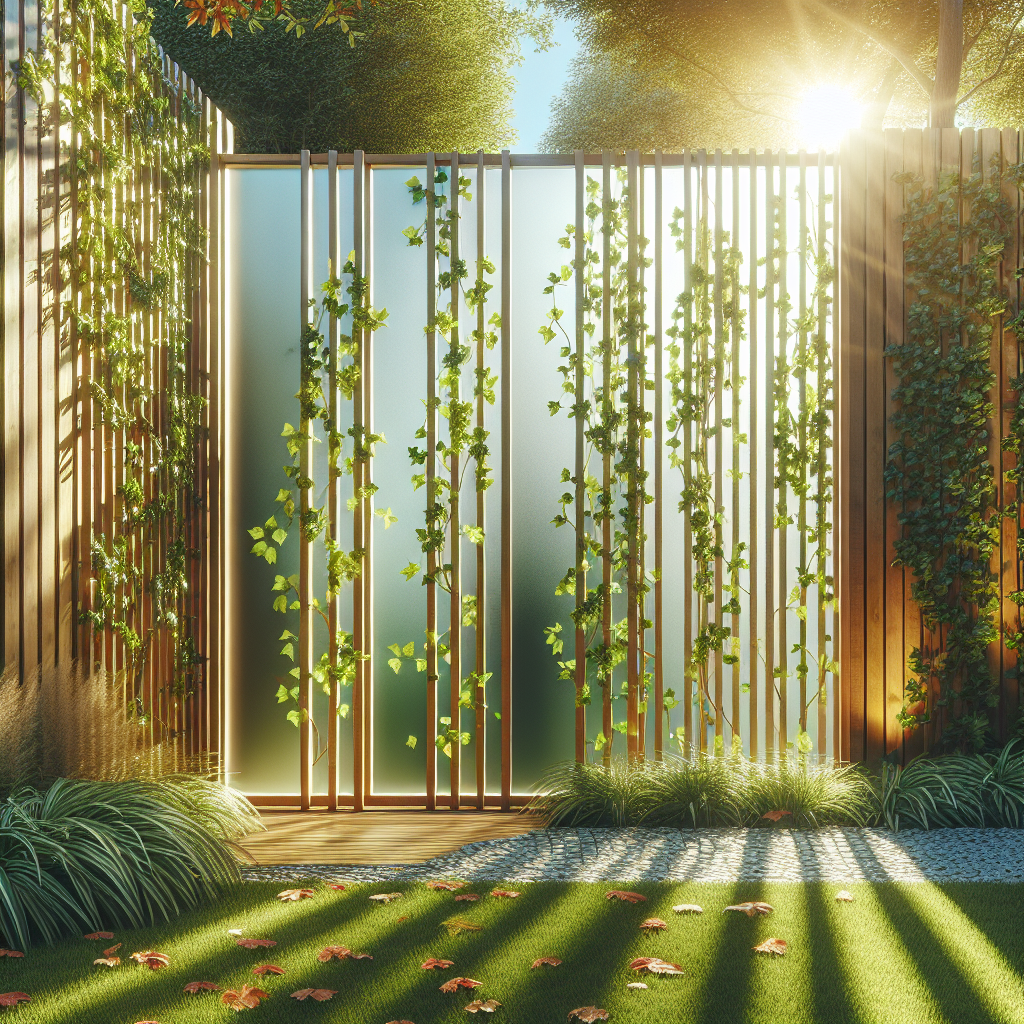You’ve built a beautiful fence around your yard, but now you’re wondering if you can add a privacy screen to further enhance your outdoor sanctuary. Whether you want to enjoy some solitude, block out nosy neighbors, or simply add a touch of style to your fence, a privacy screen can be the perfect solution. In this article, we’ll explore the benefits of privacy screens for fences, discuss the various options available, and provide tips on how to install them effectively. With a privacy screen, you can create a space that is truly your own, giving you the peace and seclusion you desire.

Types of Privacy Screens
Slatted Privacy Screens
Slatted privacy screens are a popular option for creating privacy in outdoor spaces. These screens consist of horizontal or vertical slats that are spaced apart, allowing some light to pass through while still providing privacy. Slatted privacy screens come in a variety of materials, such as wood, metal, or PVC, giving you flexibility in choosing the look that best fits your outdoor aesthetic.
Boxwood Hedges
Boxwood hedges are a classic and elegant option for creating privacy in your outdoor space. These hedges consist of densely packed boxwood plants that can be shaped and pruned to create a lush and green wall of privacy. Boxwood hedges not only provide privacy, but they also add a touch of sophistication to any outdoor setting.
Bamboo Screens
Bamboo screens are a versatile and eco-friendly option for creating privacy. These screens are made from natural bamboo poles that are held together with wire or string. Bamboo screens can be easily installed and provide a tropical and exotic feel to your outdoor space. They can also be used to create a partition or divide different areas of your yard.
Vinyl Privacy Screens
Vinyl privacy screens are a low-maintenance and long-lasting option for creating privacy. These screens are made from vinyl panels that are designed to mimic the look of wood or other materials. Vinyl privacy screens are resistant to rot, mold, and pests, making them a durable choice for outdoor use. They are also available in a variety of styles and colors, allowing you to customize your privacy screen to match your outdoor decor.
Considerations Before Installing a Privacy Screen
Local Regulations and Codes
Before installing a privacy screen, it is important to check with your local regulations and codes. Some neighborhoods or homeowner associations may have specific guidelines or restrictions on the height and type of privacy screens that are allowed. By familiarizing yourself with these regulations, you can avoid any potential conflicts or fines down the road.
Neighboring Properties
Consider the impact your privacy screen may have on your neighboring properties. It is courteous to inform your neighbors about your plans and ensure that the installation of the privacy screen does not obstruct their views or encroach on their property. Maintaining friendly relations with your neighbors is essential for a harmonious living environment.
Maintenance and Upkeep
Different types of privacy screens require varying levels of maintenance and upkeep. Consider how much time and effort you are willing to invest in maintaining your privacy screen. Some screens may require regular cleaning, trimming, or painting, while others may be relatively low-maintenance. Choosing a privacy screen that aligns with your maintenance preferences will help ensure its long-term durability.
Aesthetics
Consider the overall aesthetic appeal of the privacy screen and how it will complement your outdoor space. Depending on your personal style and the existing design elements of your yard, you may opt for a modern, rustic, or traditional privacy screen. It is important to choose a screen that enhances the visual appeal of your outdoor space while providing the desired level of privacy.
Benefits of Privacy Screens
Enhanced Privacy
The primary benefit of privacy screens is, of course, enhanced privacy. Whether you want to enjoy a quiet morning coffee on your patio or create a secluded oasis in your backyard, privacy screens offer a shield from prying eyes and create a sense of seclusion.
Noise Reduction
Privacy screens can also help reduce unwanted noise from nearby streets, neighbors, or other outdoor activities. The materials used in privacy screens can absorb and deflect sounds, creating a more peaceful and tranquil outdoor environment.
Wind and Sun Protection
In addition to providing privacy, many privacy screens also offer protection from wind and harsh sunlight. By strategically placing a privacy screen, you can create a windbreak that shields your outdoor space from strong gusts. Additionally, some privacy screens come with UV protection, which helps filter out harmful rays and keeps your outdoor area cooler.
Improved Aesthetics
Privacy screens not only provide functional benefits but also enhance the overall aesthetics of your outdoor space. With various design options available, you can choose a privacy screen that adds beauty, texture, and visual interest to your yard or patio. Privacy screens can serve as a striking focal point or seamlessly blend in with the surrounding landscape, elevating the appeal of your outdoor area.
Choosing the Right Privacy Screen
Budget Considerations
Before choosing a privacy screen, it is important to consider your budget. Privacy screens come in a range of prices, depending on the material, size, and design. Determine how much you are willing to spend and explore the options within your budget. Remember to factor in any additional costs, such as installation or maintenance, when making your decision.
Material Durability
Different materials offer varying levels of durability. Consider the weather conditions in your area and choose a material that can withstand the elements. Wood screens, for example, may require regular staining or sealing to protect against moisture and rot. Vinyl or metal screens, on the other hand, are more resistant to weather damage and often require less maintenance.
Size and Coverage
Evaluate the size and coverage you require from your privacy screen. Measure the area you want to screen off and consider whether you want partial or complete coverage. Some privacy screens can be easily adjusted or extended, while others come in fixed sizes. It is crucial to choose a screen that fits your specific needs and offers the desired level of privacy.
Design Options
Privacy screens come in a wide array of designs, allowing you to select one that matches your personal style and complements your outdoor space. From intricate lattice patterns to sleek modern panels, you can find a design that suits your aesthetic preferences. Consider the architectural style of your home and the existing elements in your yard when choosing a design for your privacy screen.

Installation Process
Measuring and Planning
Before starting the installation process, take accurate measurements of the area where the privacy screen will be installed. Plan the positioning and height of the screen to ensure maximum privacy and optimal aesthetics. Consider any existing structures, such as fences or pergolas, and how the privacy screen will integrate with them.
Preparing the Fence
If attaching the privacy screen to an existing fence, make sure it is sturdy and in good condition. If any repairs or reinforcing are needed, attend to them before installing the screen. Additionally, clean the fence to remove any dirt, debris, or old paint that may interfere with the installation process.
Attaching the Privacy Screen
Follow the manufacturer’s instructions for attaching the privacy screen to your fence or other structures. Depending on the type of screen and material, specific hardware or tools may be required. Take your time to ensure the screen is securely and evenly attached, avoiding any gaps or loose areas.
Securing the Screen
Once the privacy screen is attached, check for any areas that require extra reinforcement or additional fasteners. Secure loose ends, corners, or joints to ensure the screen remains intact, especially during inclement weather. Regularly inspect the screen to identify any signs of wear or damage and promptly address them to maintain the screen’s effectiveness and longevity.
Maintenance and Care
Cleaning and Washing
Regular cleaning is essential to keep your privacy screen looking its best. Use a soft brush or cloth and mild detergent to remove dirt, dust, and stains. Rinse thoroughly with water and allow the screen to dry completely before reinstalling it. Avoid using harsh chemicals or abrasive materials that may damage or discolor the screen.
Checking for Damage or Loose Parts
Periodically inspect your privacy screen for any signs of damage, such as cracks, chips, or rust. Check all the hardware, including screws or brackets, to ensure they are securely in place. If you notice any loose parts or structural issues, make the necessary repairs or contact a professional for assistance.
Trimming and Pruning (if applicable)
If you have a privacy screen made of living plants, such as boxwood hedges, regular trimming and pruning are necessary to maintain their shape and density. Follow proper pruning techniques and consult gardening resources to ensure you do not harm the plants. Trim away any dead or overgrown branches to promote healthy growth and continue enjoying the privacy provided by the screen.
Painting or Staining (if applicable)
Depending on the material of your privacy screen, painting or staining may be an option to refresh its appearance. Wood screens, for example, can be stained to enhance their natural beauty or painted to match your desired color scheme. Follow the manufacturer’s recommendations and use high-quality paints or stains that are suitable for outdoor use.

Legal and Insurance Considerations
Review Property Boundaries
Before installing a privacy screen, carefully review your property boundaries to ensure you do not encroach on your neighbor’s property. Consult property surveys or legal documents to accurately determine your property lines. By respecting the boundaries, you can avoid potential disputes with your neighbors in the future.
Obtain Permits (if necessary)
In some cases, you may need to obtain permits or permissions from local authorities before installing a privacy screen. Check with your municipality or homeowner association to determine if any permits are required for the specific type or size of screen you are planning to install. By obtaining the necessary permits, you can avoid fines or other legal complications.
Inform Neighbors (if required)
While it may not be a legal requirement, it is considerate to inform your neighbors about your plans to install a privacy screen. Engage in open and friendly communication, and address any concerns they may have. By keeping your neighbors informed, you can maintain positive relationships and foster a sense of goodwill within your community.
Check Insurance Coverage
It is advisable to review your homeowner’s insurance policy to verify whether your privacy screen is covered. Inquire about coverage for any potential damage to the screen, as well as liability coverage in case an accident occurs involving the screen. If necessary, consider updating your insurance policy to include the privacy screen as part of your property coverage.
Alternative Options for Privacy
Planting Shrubs or Trees
If you prefer a natural and green solution, consider planting shrubs or trees to create privacy. Depending on the size and type of plants you choose, they can serve as living privacy screens that also offer additional benefits, such as shade and improved air quality. Research the best plant species for your climate and ensure proper care and maintenance to foster healthy growth.
Installing Outdoor Curtains
Outdoor curtains are an excellent option for creating privacy on patios, pergolas, or gazebos. These versatile and decorative curtains can be easily installed using rods or hooks. Choose materials that are weather-resistant and quick-drying to withstand outdoor conditions. Outdoor curtains also provide flexibility, allowing you to adjust the level of privacy and light as desired.
Constructing a Pergola or Trellis
Building a pergola or trellis can provide both privacy and architectural interest to your outdoor space. These structures can be customized with lattice panels, fabric screens, or climbing plants to create a visually appealing and secluded area. When constructing a pergola or trellis, consult local building regulations and obtain any necessary permits beforehand.
Using Outdoor Privacy Screens
Alternatively, you can opt for purpose-built outdoor privacy screens that offer portability and versatility. These screens are available in various sizes and designs, allowing you to easily move them as needed or adjust their configuration. Outdoor privacy screens can be made from different materials, such as fabric, wood, or metal, giving you options that match your style and requirements.

Common Mistakes to Avoid
Choosing the Wrong Material
One common mistake is selecting a privacy screen material that is not suited to your specific needs and outdoor conditions. Consider factors such as weather resistance, durability, and maintenance requirements before making your choice. Avoid materials that may not withstand the elements or require excessive upkeep, as this can lead to dissatisfaction and additional expenses in the long run.
Ignoring Local Regulations
Failing to research and comply with local regulations and codes is another common mistake. Ensure you understand any height restrictions, setback requirements, or visual guidelines before installing your privacy screen. By following the rules, you can avoid potential penalties or having to remove and reinstall the screen to meet regulations.
Neglecting Maintenance
Privacy screens, like any outdoor feature, require regular maintenance to retain their functionality and appearance. Neglecting proper care, such as cleaning, repairing, or trimming, can result in a decline in their effectiveness or premature deterioration. Establish a maintenance routine and dedicate time to care for your privacy screen, ensuring its longevity and continued enjoyment.
Installing Improperly
Improper installation can lead to a variety of issues, from instability to unsightly gaps or damage. Take the time to read and follow the manufacturer’s instructions when installing your privacy screen. If you are unsure or not experienced with this type of work, it may be wise to seek professional assistance to ensure a secure and aesthetically pleasing installation.
Conclusion
Privacy screens offer a practical and aesthetically pleasing solution for creating privacy in your outdoor space. With a variety of options to choose from, such as slatted screens, boxwood hedges, bamboo screens, and vinyl screens, there is sure to be a privacy screen that suits your needs and complements your outdoor aesthetics.
Before installing a privacy screen, consider factors such as local regulations, neighboring properties, maintenance requirements, and the desired aesthetics. By carefully selecting a privacy screen that aligns with your preferences, you can enjoy enhanced privacy, reduced noise, protection from wind and sun, and improved outdoor aesthetics.
When choosing a privacy screen, take into account your budget, material durability, desired size and coverage, and design options. Proper installation is crucial for optimal performance and longevity, so follow the recommended measuring, planning, and attachment processes. Regular maintenance, including cleaning, checking for damage, and trimming or painting (if applicable), will keep your privacy screen looking and functioning at its best.
Take into consideration legal and insurance considerations, including property boundaries, necessary permits, informing neighbors, and reviewing insurance coverage. Explore alternative options for privacy, such as planting shrubs or trees, installing outdoor curtains, constructing a pergola or trellis, or using purpose-built outdoor privacy screens.
Avoid common mistakes like choosing the wrong material, ignoring local regulations, neglecting maintenance, or installing the privacy screen improperly. By avoiding these errors, you can ensure a successful and satisfying privacy screen installation that enhances your outdoor space and provides lasting privacy for you and your family. So go ahead and transform your outdoor area into a secluded oasis with the perfect privacy screen for your needs.

